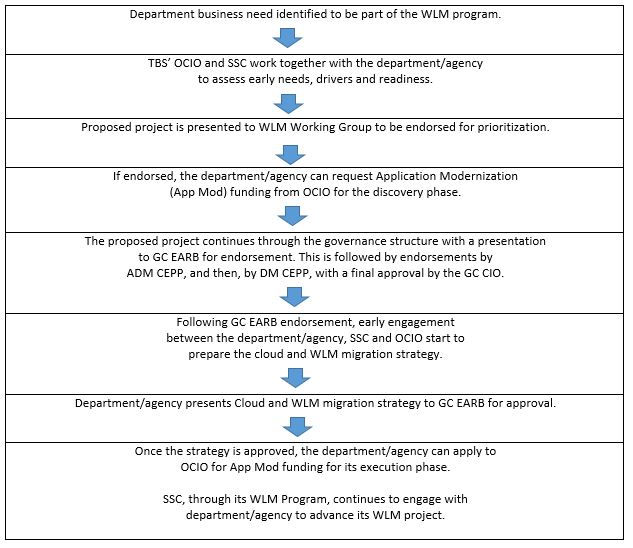Important: The GCConnex decommission will not affect GCCollab or GCWiki. Thank you and happy collaborating!
Difference between revisions of "Workload Migration (WLM) Program"
| Line 47: | Line 47: | ||
=== '''Governance approval process''' === | === '''Governance approval process''' === | ||
[[File:WLM Governance Process.jpg|left|thumb|626x626px]] | [[File:WLM Governance Process.jpg|left|thumb|626x626px]] | ||
| + | |||
| + | |||
| + | |||
| + | |||
| + | |||
| + | |||
| + | |||
| + | |||
| + | |||
| + | |||
| + | |||
| + | |||
| + | |||
| + | === '''Step by step process''' === | ||
| + | [[File:STEP BY STEP PROCESS.jpg|left|thumb|615x615px]] | ||
| + | |||
| + | |||
| + | |||
| + | |||
| + | |||
| + | |||
| + | |||
| + | |||
| + | |||
| + | |||
| Line 63: | Line 88: | ||
| − | |||
| − | |||
Revision as of 14:18, 21 July 2020
Remarque: la version française est disponible dans le panneau de navigation à gauche.
Introduction
Are you a department or agency looking for information on Shared Services Canada (SSC) Workload Migration Program and how it is delivered? If yes, you’ve come to the right place!
What is the purpose of the Workload Migration Program?
Under SSC 3.0, the Workload Migration (WLM) Program facilitates the migration of government applications from aging legacy data centres to modern, more secure and reliable solutions – whether cloud, state-of-the-art enterprise data centre (EDC) or a hybrid of the two. The ultimate purpose is to migrate department workloads to reliable, modern, and secure hosting options.
More specifically, the Program:
- Oversees a series of workload migration projects that will move GC applications and data out of aging EDC;
- Initiates enablement projects and activities pertaining to enterprise approaches;
- Provides funding for the emergency closing of small- to medium-sized legacy data centres.
Since it formally launched in 2018, the WLM Program currently has 14 projects underway (six in Wave 1 and eight in Wave 2).
What's in it for my Department or Agency?
Application health is a key Government of Canada priority. A WLM project will provide your department or agency with one or more of the following opportunities:
- Prioritize your portfolio of applications for modernization and migration
- Leverage new Cloud technologies
- Support TB policy and strategy direction such as the Policy on the Management of Information Technology, the Policy on Service, and the Digital Operations Strategic Plan
- Reduce risk and increase reliability
- Improve GC cyber security
If your department of agency is impacted by a WLM project, you will benefit from outcomes such as:
- Reliable IT infrastructure to ensure successful delivery of the government programs and services for Canadians.
- Modern technology provides Canadians with digital technology to receive the services they need.
- Secure cyber and IT security that is able to protect the privacy of Canadians and others interacting with the government.
How does a WLM project get prioritized, endorsed and approved?
SSC works in collaboration with the Office of the Chief Information Officer (OCIO) at Treasury Board Secretariat (TBS) to prioritize WLM projects based on the state of the data centre, the health of the applications, and the readiness of the partner department or agency.
The prioritization of WLM projects requires the approval from the Government of Canada Chief Information Officer (GC CIO), following endorsements from the following governance bodies:
- WLM Working Group (co-chaired by SSC’s WLM Program and TBS’ OCIO)
- GC Enterprise Architecture Review Board (GC EARB)
- Assistant Deputy Minister Committee on Enterprise Priorities and Planning (ADM CEPP)
- Deputy Minister Committee on Enterprise Priorities and Planning (DM CEPP)
Governance approval process
Step by step process
Frequently Asked Questions (FAQ)
SSC in collaboration with the Office of the Chief Information Officer (OCIO) at Treasury Board Secretariat (TBS) developed a Frequently Asked Question (FAQ) document to provide departments with additional information to understand how the WLM Program supports departments and agencies through its projects and activities.
For any further questions or comments, please contact our [Program delivery team].


